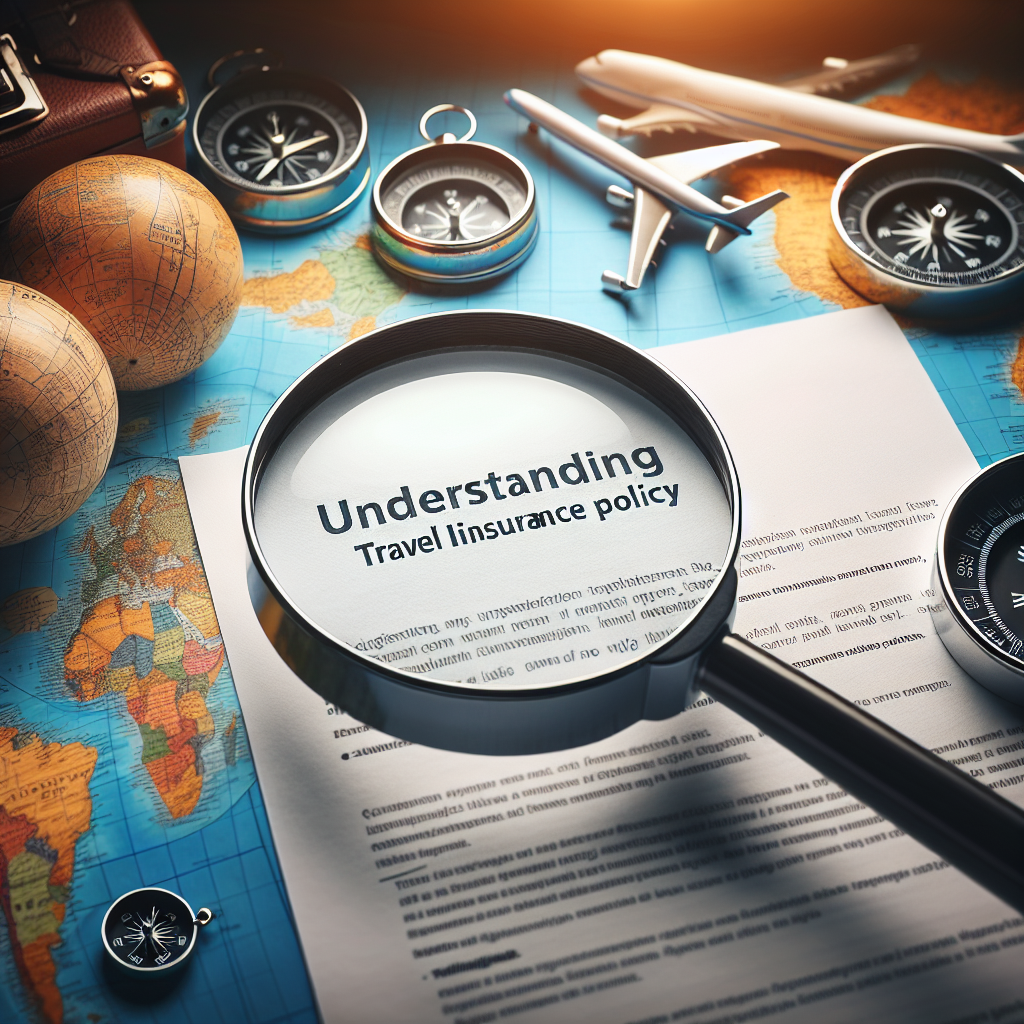You’re planning an exciting trip, and part of your preparation includes getting travel insurance. However, when you receive the policy document, all the terms and conditions seem overwhelming. Don’t worry, we’ve got you covered! In this article, we’ll provide you with useful tips to help you read and understand your travel insurance policy. With these tips, you’ll gain clarity and peace of mind, knowing exactly what you’re covered for and what to do in case of any unexpected events during your travels. So, let’s dive in and become an informed traveler!
Understanding the Basics of Travel Insurance
Travel insurance is a type of insurance coverage that provides protection against financial losses and medical expenses incurred during your travels. It is designed to give you peace of mind and protect you from unexpected events that may occur while you are away from home. Whether you are going on a short vacation or a long-term journey, having travel insurance is essential to ensure that you are adequately covered in case of an emergency or unforeseen circumstances.
Definition of Travel Insurance
Travel insurance is a contract between you and the insurance company that outlines the terms and conditions of coverage. It typically provides protection against trip cancellations, medical emergencies, lost or stolen baggage, and other travel-related risks. The policy is valid for a specific period of time, usually from the day of departure to the day of return. Depending on the type of coverage you choose, travel insurance may also include additional benefits such as coverage for adventure sports and activities, rental car damage, and personal liability.

Why Travel Insurance is Essential
Travel insurance is essential because it offers protection and financial security in the face of unexpected situations. While planning a trip, you may not anticipate events like trip cancellations, lost luggage, or medical emergencies. However, these situations can occur, and without travel insurance, you may find yourself facing significant financial losses. Travel insurance provides you with a safety net, ensuring that you are properly covered and allowing you to enjoy your trip with peace of mind.
Different Types of Travel Insurance
There are several different types of travel insurance policies available, catering to the specific needs and preferences of travelers. Some common types of travel insurance include:
-
Trip cancellation insurance: This type of insurance covers the cost of your trip if you have to cancel or interrupt it due to unforeseen circumstances such as illness, injury, or other covered reasons.
-
Medical and emergency insurance: This coverage provides reimbursement for medical expenses, emergency medical evacuation, and other related costs that may arise during your trip.
-
Baggage and personal possessions insurance: This coverage protects your personal belongings, including baggage, against loss, theft, or damage while you are traveling.
-
Trip delay or interruption insurance: This coverage provides compensation for additional expenses incurred due to trip delays or interruptions caused by covered reasons, such as bad weather or airline strikes.
-
Adventure sports and activities coverage: If you plan to participate in adventure sports or activities during your trip, this coverage ensures that you are protected against any potential accidents or injuries.
It is important to carefully review the specific terms, conditions, and coverage limits of each type of travel insurance policy to determine which one best suits your needs and budget.

Diving Deep into the Policy Details
Once you have chosen a travel insurance policy, it is crucial to understand its specific details and provisions. This will help you make informed decisions and ensure that you are fully aware of what is covered and what is not.
Term And Validity of the Policy
The term of your travel insurance policy refers to the period for which you will be covered. It typically starts from the day of departure and ends on the day of return. It is important to carefully check the validity of the policy to ensure that it aligns with the dates of your trip. If your travel plans change or you need to extend your trip, it is essential to notify your insurance provider and make the necessary adjustments to your policy.
Policy Inclusions and Exclusions
It is essential to thoroughly review the inclusions and exclusions of your travel insurance policy to understand what is covered and what is not. Inclusions are the specific events or circumstances that are covered by the policy, such as trip cancellations due to illness or lost baggage. Exclusions, on the other hand, are the events or circumstances that are not covered, such as pre-existing medical conditions or losses resulting from reckless behavior. Understanding these details will help you manage your expectations and ensure that you are adequately covered for the risks you may encounter during your trip.
Claim Limit and Deductibles
When selecting a travel insurance policy, it is important to understand the claim limits and deductibles associated with it. The claim limit is the maximum amount that the insurance company will pay for a specific type of claim. For example, if your policy has a claim limit of $10,000 for medical expenses, the insurance company will only reimburse you up to that amount. Deductibles, on the other hand, are the amount you have to pay out of pocket before the insurance coverage kicks in. For instance, if your policy has a deductible of $500 for lost baggage, you will be responsible for covering the first $500 of the loss, and the insurance company will reimburse you for the remaining amount.
Understanding the claim limits and deductibles of your travel insurance policy will help you plan and budget accordingly. It is important to ensure that the coverage limits are sufficient to meet your needs and that you are comfortable with the deductibles.
Specific Coverages in Travel Insurance Policy
Travel insurance policies offer various coverages that are crucial in protecting you during your travels. Understanding these specific coverages will help you make informed decisions when selecting a policy and ensure that you have the necessary protection in place.
Trip Cancellation and Interruption Cover
Trip cancellation and interruption coverage is designed to compensate you for non-refundable travel expenses in the event that you have to cancel or interrupt your trip due to covered reasons. Covered reasons may include illness, injury, death of a family member, natural disasters, or other unforeseen circumstances. The coverage typically reimburses prepaid expenses such as flights, accommodation, and tours, ensuring that you do not suffer financial losses if your trip does not go as planned.
Medical and Emergency Cover
Medical and emergency coverage is one of the most crucial aspects of travel insurance. It provides reimbursement for medical expenses incurred during your trip, including doctor’s visits, hospital stays, prescription medications, and emergency medical evacuation. This coverage ensures that you receive the necessary medical care, regardless of your location, and protects you from the high costs associated with healthcare abroad.
Baggage and Personal Possessions Coverage
Baggage and personal possessions coverage protects your belongings against loss, theft, or damage while you are traveling. It typically includes coverage for checked luggage, carry-on bags, and personal items such as cameras, laptops, and jewelry. If your baggage is lost, stolen, or damaged during your trip, the insurance company will reimburse you for the cost of the items, up to the policy’s coverage limits. This coverage provides peace of mind, knowing that you are financially protected in case of any mishap involving your belongings.

Recognizing the Limitations and Exclusions
While travel insurance offers valuable protection, it is important to be aware of its limitations and exclusions. Understanding these limitations will prevent any surprises or misunderstandings when it comes time to make a claim.
Pre-existing Medical Conditions
Most travel insurance policies do not cover pre-existing medical conditions. A pre-existing medical condition refers to an illness or injury that you already had before purchasing the policy. If you have a pre-existing condition, it is crucial to disclose it to the insurance company during the application process. In some cases, you may be able to obtain coverage for your condition by paying an additional premium or by obtaining a separate policy specifically designed for pre-existing conditions.
Adventure Sports and Activities
Many travel insurance policies exclude coverage for adventure sports and activities such as skiing, scuba diving, and bungee jumping. If you plan to engage in these activities during your trip, it is important to check if your policy includes coverage for them. If not, you may need to purchase additional coverage or a separate policy that specifically covers these activities.
War and Terrorism Exclusions
Travel insurance policies typically do not cover losses or damages caused by war or acts of terrorism. While it is unlikely that you will encounter such situations during your trip, it is important to be aware of this exclusion in your policy. If you are traveling to a destination with a known risk of political instability or conflict, it may be advisable to purchase additional coverage that specifically addresses these risks.
Identifying the Extension Options
Extensions allow you to customize your travel insurance policy to better suit your needs and preferences. They provide additional coverage for specific events or circumstances that may not be included in the standard policy. Identifying the extension options available to you will help you tailor your coverage and ensure that you are adequately protected.
Why Extensions are Important
Extensions are important because they provide additional coverage beyond the standard policy limits. They allow you to address specific risks or events that are not covered by the base policy. By adding extensions, you can enhance your comprehensive coverage and ensure that you have protection in place for all of your travel needs.
Common Extensions Available
Common extensions available in travel insurance policies include:
-
Rental car damage coverage: This extension provides coverage for damage or theft of rental cars used during your trip.
-
Increased coverage limits: If the standard coverage limits of your policy are not sufficient, you can add extensions to increase the limits for specific types of coverage, such as medical expenses or baggage loss.
-
Cancel for any reason coverage: This extension allows you to cancel your trip for any reason and receive reimbursement for non-refundable expenses.
-
Sports equipment coverage: If you plan to travel with expensive sports equipment, such as golf clubs or skis, you can add an extension to ensure that they are covered against loss, theft, or damage.
It is important to carefully consider your specific needs and preferences when choosing extensions. Adding the right extensions will provide you with a comprehensive policy that addresses all of your travel-related risks.
Cost of Policy Extensions
The cost of policy extensions varies depending on the insurance company, the type of extension, and the level of coverage you choose. Some extensions may be available at no additional cost, while others may require an additional premium. It is important to review the cost of extensions and consider them in relation to the overall cost of your travel insurance policy. Balancing the benefits of added coverage with the cost of extensions will help you make an informed decision and select the extensions that provide the most value for your money.

Process for Making a Claim
In the unfortunate event that you need to make a claim on your travel insurance policy, it is important to familiarize yourself with the process to ensure a smooth and efficient claims settlement.
Exact Process of Filing a Claim
The exact process of filing a claim may vary depending on the insurance company. However, there are some general steps that apply to most travel insurance claims:
-
Contact your insurance company: As soon as you encounter an event or circumstance that may give rise to a claim, contact your insurance company to report the incident. They will provide you with the necessary instructions and guidance.
-
Complete the claim form: The insurance company will require you to complete a claim form. This form will ask for details about the incident, the expenses you have incurred, and any supporting documentation you may have.
-
Gather supporting documentation: Collect all the necessary supporting documentation to substantiate your claim. This may include medical reports, receipts, photographs, police reports, and any other relevant evidence.
-
Submit the claim form and supporting documentation: Once you have completed the claim form and gathered all the required documentation, submit them to the insurance company. Make sure to keep copies of all documents for your records.
-
Follow up on the claim: After submitting your claim, it is essential to follow up with the insurance company to ensure that it is being processed. Be proactive in providing any additional information or documentation requested by the company.
-
Receive claim settlement: Once your claim has been processed and approved, the insurance company will provide you with the appropriate settlement. This may be in the form of reimbursement for expenses incurred or direct payment to the service providers.
Documents Required for Claim
The specific documents required for a travel insurance claim will depend on the nature of the claim and the insurance company’s requirements. However, some common documents that may be requested include:
- Copies of the policy and certificate of insurance
- Completed claim form
- Proof of travel, such as tickets, itineraries, or boarding passes
- Medical reports and receipts for medical expenses
- Police reports or incident reports for theft or loss
- Photographs or videos of damaged property or belongings
- Any other relevant documentation or evidence related to the claim
It is important to keep all original documents and make copies for submission to the insurance company. Maintaining good records will help facilitate the claims process and ensure that you have the necessary evidence to support your claim.
Timeline for Claim Settlement
The timeline for claim settlement will vary depending on the complexity of the claim and the insurance company’s internal processes. In general, insurance companies strive to settle claims as quickly as possible. However, it is important to be aware that some claims may require further investigation or verification, which can extend the settlement timeline. It is advisable to follow up regularly with the insurance company and provide any additional information or documentation they may require to expedite the claims settlement process.
Understanding the Appeals Process
In the event that your claim is denied, it is important to understand the appeals process and your rights as a policyholder. While it can be frustrating to have a claim denied, there are steps you can take to appeal the decision and seek a reconsideration.
How to Appeal a Denied Claim
To appeal a denied claim, follow these steps:
-
Review the denial letter: Carefully review the denial letter provided by the insurance company. It should outline the reasons for denying your claim and provide any specific instructions for filing an appeal.
-
Gather additional evidence: If you believe that the denial is not justified, gather any additional evidence or documentation that supports your claim. This could include medical records, expert opinions, or other relevant information.
-
Prepare your appeal letter: Write a formal appeal letter addressed to the insurance company. Clearly state your reasons for disagreeing with the denial and provide any new evidence or information that supports your claim. Be concise, but thorough, in explaining your position.
-
Submit your appeal: Send your appeal letter and any supporting documents to the insurance company. Ensure that you meet any specified deadlines for submitting the appeal.
-
Follow up on the appeal: After submitting your appeal, follow up with the insurance company to ensure that it has been received and is being reviewed. Be proactive in providing any additional information or documentation requested by the company.
-
Seek legal advice if necessary: If your claim is still denied after exhausting the appeals process, you may want to consider seeking legal advice from an attorney who specializes in insurance law. They can provide guidance on your legal rights and options for further action.
Timeframe for Appeals
The timeframe for appeals may vary depending on the insurance company’s internal processes and policies. It is important to carefully review the denial letter and any accompanying documents to determine the specified deadline for submitting an appeal. Adhering to this deadline is crucial to ensure that your appeal is considered and processed in a timely manner.
Documents Required for Appeals
The specific documents required for an appeal will depend on the insurance company’s requirements and the nature of the denial. However, some common documents that may be requested include:
- Appeal letter clearly stating your position and reasons for disagreeing with the denial
- Any new evidence or documentation that supports your claim
- Copies of the original claim form and supporting documents
- Any correspondence or communications related to the claim and denial
It is important to review the insurance company’s instructions and requirements for appeals and provide any requested documentation in a timely manner. This will help support your case and maximize your chances of a favorable outcome.

Reviewing the Policy Regularly
While it may be tempting to purchase a travel insurance policy and forget about it, it is important to regularly review your policy to ensure that it still meets your needs and provides adequate coverage. Life circumstances and travel plans can change, and it is crucial to modify your policy as necessary.
Importance of Regular Reviews
Regularly reviewing your travel insurance policy is important for several reasons:
-
Ensuring adequate coverage: Travel plans and destinations can change, and it is crucial to ensure that your policy provides sufficient coverage for your specific travel needs. By reviewing your policy regularly, you can identify any gaps in coverage and make the necessary adjustments to your policy.
-
Adjusting to life changes: Changes in your personal circumstances, such as a change in marital status, the birth of a child, or a change in health conditions, may impact your insurance needs. Regularly reviewing your policy allows you to update your coverage to reflect these changes.
-
Assessing policy cost-effectiveness: Travel insurance policies can vary in terms of coverage and cost. By reviewing your policy regularly, you can assess whether you are getting the best value for your money or if there are more cost-effective options available.
When Should You Review Your Policy
It is advisable to review your travel insurance policy before each trip, as well as annually or whenever there are significant changes in your travel plans or personal circumstances. Some specific instances when you should review your policy include:
-
Before booking a trip: Reviewing your policy before booking a trip allows you to assess whether the coverage provided aligns with your specific travel needs. This will help you make an informed decision when selecting a policy and ensure that you are adequately protected from the start of your journey.
-
When planning a trip to a different destination: If you are planning a trip to a destination with unique risks or requirements, it is important to review your policy to ensure that it provides adequate coverage for those specific risks. Some destinations may require additional coverage for medical emergencies, natural disasters, or political instability.
-
When changes in personal circumstances occur: Life changes such as marriage, the birth of a child, or a change in health conditions can impact your insurance needs. Reviewing your policy during these times will help you determine if any adjustments are necessary to ensure adequate coverage.
It is important to review your policy well in advance of your trip to allow sufficient time to make any necessary adjustments or changes.
Modifying Your Policy Post-Review
After reviewing your travel insurance policy, if you identify any gaps in coverage or determine that modifications are necessary, you should contact your insurance provider to discuss your options. They will advise you on any adjustments you can make to your policy and provide guidance on the associated costs and implications. It is crucial to make any modifications to your policy before your trip to ensure that you are adequately covered from the start.
Interacting with Customer Service
Interacting with customer service is an integral part of the travel insurance experience. Whether you have a question, need assistance with a claim, or want to make changes to your policy, customer service representatives play a crucial role in providing guidance and support.
Role of Customer Service in Insurance
Customer service is the primary point of contact between policyholders and insurance companies. The role of customer service representatives in the insurance industry is to:
-
Answer questions and provide information: Customer service representatives are there to answer any questions you may have about your policy, coverage, or claims process. They can provide information, clarify policy details, and address any concerns or issues you may have.
-
Assist with claims processes: If you need to make a claim, customer service representatives can guide you through the process, provide instructions, and address any questions or concerns you may have. They play a crucial role in ensuring that the claims process runs smoothly and efficiently.
-
Help with policy modifications: If you need to make changes to your policy, such as adding extensions or adjusting coverage limits, customer service representatives can assist you with these modifications. They can provide guidance on the available options, associated costs, and any required documents or information.
Evaluating the Effectiveness of Customer Service
Effective customer service is essential in the insurance industry. When evaluating the effectiveness of customer service, consider the following factors:
-
Responsiveness: A good customer service team should be responsive and timely in addressing inquiries or concerns. They should be readily available to assist policyholders and provide prompt and efficient service.
-
Knowledge and expertise: Customer service representatives should have a good understanding of the insurance industry, policies, and claims processes. They should be knowledgeable and able to provide accurate information and guidance to policyholders.
-
Professionalism and courtesy: Customer service representatives should be professional and courteous when interacting with policyholders. They should be patient, empathetic, and understanding of the policyholder’s needs and concerns.
-
Problem-solving ability: A good customer service team should have the ability to effectively resolve problems or issues that arise. They should be proactive in finding solutions and ensuring policyholders are satisfied with the outcome.
Possible Issues with Customer Service
While good customer service is essential, there can be instances where policyholders encounter issues or challenges when interacting with customer service. Some common issues include:
-
Difficulty reaching customer service: Long wait times or inability to reach a customer service representative can be frustrating for policyholders. It is important for insurance companies to have sufficient staffing to handle customer inquiries and provide timely support.
-
Lack of clarity or inconsistent information: In some cases, policyholders may receive conflicting or unclear information from different customer service representatives. This can lead to confusion and a lack of trust in the company. Insurance companies should have clear and consistent communication protocols to ensure that accurate and reliable information is provided at all times.
-
Unsatisfactory resolution of claims: If a policyholder’s claim is not handled to their satisfaction, it can lead to frustration and a breakdown in trust. Insurance companies should have a clear and efficient claims process and be responsive to policyholders’ concerns or requests for clarification.
If you encounter any issues or challenges when interacting with customer service, it is important to escalate your concerns to higher levels within the insurance company. This will ensure that your concerns are addressed and that you receive the necessary support and assistance.
Navigating the Fine Print
Understanding the fine print of your travel insurance policy is crucial to ensure that you are aware of all terms, conditions, and exclusions. The fine print contains important details that may impact the coverage and benefits provided by the policy.
Importance of Reading Fine Print
Reading the fine print of your travel insurance policy is important for several reasons:
-
Understanding coverage limitations: The fine print often outlines specific limitations or exclusions that may restrict or limit coverage. By reading the fine print, you can identify any gaps in coverage and assess whether the policy meets your needs.
-
Identifying policy requirements: The fine print may contain specific requirements or conditions that must be met in order to qualify for coverage. For example, it may specify certain timeframes for filing claims or outline documentation requirements. Understanding these requirements will help you ensure compliance and prevent any issues when making a claim.
-
Managing expectations: The fine print provides important details that help manage expectations regarding what is covered and what is not. By reading the fine print, you can have a realistic understanding of the coverage provided and avoid any surprises or misunderstandings.
Commonly Overlooked Details in Fine Print
When reading the fine print, it is important to pay attention to the following commonly overlooked details:
-
Pre-existing medical conditions: Many policies exclude coverage for pre-existing medical conditions. The fine print will detail what is considered a pre-existing condition and any limitations or exclusions associated with these conditions.
-
Coverage limits and deductibles: The fine print will outline the specific coverage limits and deductibles associated with your policy. It is important to understand these limits to ensure that they are sufficient to meet your needs and that you are comfortable with the associated deductibles.
-
Exclusions and limitations: The fine print will provide a detailed list of exclusions and limitations that may impact your coverage. It is important to review these exclusions to ensure that they align with your needs and expectations.
-
Claim requirements and procedures: The fine print may include details about how to file a claim, required documentation, and any specific timeframes for filing claims. Paying attention to these requirements will ensure that you are prepared and able to meet the necessary criteria when making a claim.
By paying careful attention to these commonly overlooked details, you can ensure that you have a thorough understanding of your travel insurance policy and avoid any surprises or issues during your travels.
Asking for Clarification on Fine Print
If you have any questions or need clarification on the fine print of your travel insurance policy, do not hesitate to reach out to your insurance provider’s customer service team. They can provide you with the necessary guidance and address any concerns or uncertainties you may have. It is important to have a clear understanding of the policy’s terms and conditions to ensure that you are adequately covered and can make informed decisions.
In conclusion, understanding the basics of travel insurance is essential for every traveler. From the definition of travel insurance to the different types available, knowing the ins and outs of your policy is crucial in order to make the right decisions. Diving deep into the policy details helps you familiarize yourself with the specific provisions, coverages, and limitations. Identifying the extensions options allows you to tailor your policy to your unique needs. Understanding the process for making a claim and appealing a denied claim ensures that you are prepared for any unforeseen circumstances. Reviewing your policy regularly, interacting with customer service, and navigating the fine print are all important steps in making educated choices and maintaining a comprehensive travel insurance policy. With this knowledge, you can embark on your travels with confidence and peace of mind, knowing that you are protected against unexpected events.

